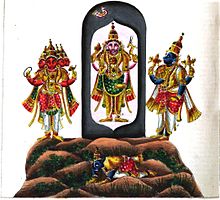三相神
三相神 | |
 在埃洛拉石窟的三相神: 梵天、毗濕奴和濕婆(从左到右) | |
印度教三相之神 | |
| 梵文名稱 | त्रिमूर्ति |
|---|---|
| 梵語轉寫 | trimūrti |
| 體系 | 提婆 |
| 配偶 | 三女神 |
此網頁中使用了婆罗米系文字。若您的系統不支持,您會看到母音重音標示的位置不正確以及缺乏正確的連結詞。 | |
三相神(梵文:त्रिमूर्तिः trimūrti),在梵文中原意為“有三種形式”,是印度教的一个概念,“将宇宙的创造、维持和毁灭的功能分别人性化为创造者梵天,维护者或保护者毗濕奴,以及毁灭者或转化者濕婆” [1][2]。这三位神灵被认为是“印度教的三合一(the Hindu triad)”[3]或“伟大的三位一体”[4],或称为“梵天-毗濕奴-濕婆”。
印度哲學家(比如数论派)常用三德(Guna)來解釋三相神:
答磨(暗,Tamas)表示無知、懶惰及靈性的黑暗,和毀滅之神濕婆有關。
罗阇(忧,Rajas)表示活動、熱情及新的開始,和梵天有關。
萨埵(喜,Sattva)表示純淨、友善及和諧,和毗濕奴有關。[5]
三德也對應三種顏色及地球的三個成份:答磨為黑色,對應地球上的火、罗阇為紅色,對應地球上的土、萨埵為白色,對應地球上的水。[5]
目录
1 發展
2 印度教中的观点
2.1 绍拉派
2.2 毗濕奴派
2.3 湿婆派
2.4 传统派
3 参考文献
3.1 引用
3.2 来源
4 外部链接
5 参见
發展

安得拉邦的畫三相神

在哈勒比德的霍沙勒斯哇拉庙中三相神的藝術刻畫
在往世书时期(Puranic period,大约公元前300-1200年),后吠陀宗教和玛兹穆德所谓的“综合印度教(synthetic Hinduism)”逐渐兴起。[6]这一时期印度各宗派还没有同质化,继承古老吠陀信仰传统的正统古婆罗门教和其他在正统框架下的不同教派(知名的比如濕婆派、毗湿奴派、性力派)共存。[7]这一时期的重要特质之一就是正统派和其他宗派的和谐共存。[8]关于这种和谐共处的潮流,玛兹穆德提到:
它的最值得关注的表现可以在三相神的宗教概念中发现,比如至高神的表现形式有三种形式:梵天、毗濕奴、湿婆……但是这种尝试可能并不成功,因为梵天从没有得到超出湿婆或毗濕奴的统治地位,不同的教派常常认为三相神是自己教派的主神的三种表现形式,认为本教派的主神是梵或绝对真理。[9]
莫里斯·温特尼茨注意到印度文学中很少提到三相神。[10]《龟往世书》(Kūrma Purāṇa)十分强调梵天、毗濕奴、湿婆是同一神,而在第1.6节中梵被崇拜为三相神;第1.9节也特别反复灌输这三神的同一性;第1.26节也提到同样的主题。[11]
历史学家巴斯汉姆解释三相神的背景时,提到西方对三位一体的兴趣:
早期学习印度教的西方学生对与基督教类似的印度教的三位一体印象深刻。事实上这种类似并不够紧密。不像基督教的三位一体,印度教的三位一体从没有真正“流行起来(caught on)”。所有的印度教三位一体派都倾向于偏爱这三神中的某个神;因此,从这个背景来看,很明显迦梨陀娑的献给三相神的赞美诗实际上是献给被认为是至高神的梵天的。三相神实际上是人为的拔高,并没有太多的真正影响。[12]
弗里达·玛切特(Freda Matchett)描述三相神系统为“多种神的形象可以在不同的层次被组合的框架”[13]
三相神的概念在弥勒奥义书也出现过,这里三神被解释为至高神的三种首要形式。[14]
印度教中的观点
绍拉派
绍拉派(Sauram)崇拜太阳神蘇利耶为至高神,下梵不接受三相神。早期的三相神形式包括有蘇利耶而不是梵天,或者将蘇利耶作为高于三相神的至高神,认为三相神是蘇利耶的三种表现形式。蘇利耶在早上是梵天,下午是毗濕奴,晚上是湿婆。有些绍拉派崇拜毗濕奴或湿婆为蘇利耶的表现形式,另一些则膜拜三相神作为蘇利耶的表现形式,还有些仅仅专门崇拜蘇利耶。
毗濕奴派

毗濕奴和吉祥天女在巨蛇舍沙身上,梵天从毗濕奴肚脐中的莲花中出现。
毗湿奴派一般不接受三相神的概念。例如,二元论派坚持毗濕奴单独是至高神,湿婆是下属,对往世书有不同解释。二元论派学者Vijayindra Tîrtha认为毗湿奴往世书(Vaishnavite puranas)是喜往世书,湿婆往世书(Shaivite puranas)是暗往世书,仅仅喜往世书(satvic puranas)是有权威的。[15]
湿婆派

湿婆神庙
湿婆派根据湿婆阿含经坚持,湿婆神有五个功能——创造,保护,毁灭,隐藏恩赐(concealing grace),显露恩赐(revealing grace)。这五个功能每一个都对应湿婆的一个名字和形式。湿婆是至高神,三相神是湿婆的一种形式。[16]

Lingodbhava murti
传统派
传统派(Smartism)强调五神系统,而不是一个神[17]。9世纪哲学家商羯罗使得五神系统流行。该系统崇拜五个神灵——象头神、毗湿奴、湿婆、提毗、蘇利耶[18][19]。商羯罗后来又加入室建陀,称为六神。商羯罗推广这个系统同一用以联合以这六神为主要神的各大主要教派。[20]
参考文献
引用
^ For quotation defining the trimurti see Matchett, Freda. "The Purāṇas", in: Flood (2003), p. 139.
^ For the Trimurti system having Brahma as the creator, Vishnu as the maintainer or preserver, and Shiva as the transformer or destroyer. see Zimmer (1972) p. 124.
^ For definition of trimurti as "the unified form" of Brahmā, Viṣṇu and Śiva and use of the phrase "the Hindu triad" see: Apte, p. 485.
^ For the term "Great Trinity" in relation to the Trimurti see: Jansen, p. 83.
^ 5.05.1 Wolfgang Bauer, Irmtraud Dümotz, Sergius Golowin: Lexikon der Symbole. Heyne 2001
^ For dating of Puranic period as c. CE 300-1200 and quotation, see: Majumdar, R. C. "Evolution of Religio-Philosophic Culture in India", in: Radhakrishnan(CHI, 1956), volume 4, p. 47.
^ For characterization as non-homogeneous and including multiple traditions, see: Majumdar, R. C. "Evolution of Religio-Philosophic Culture in India", in: Radhakrishnan(CHI, 1956), volume 4, p. 49.
^ For harmony between orthodox and sectarian groups, see: Majumdar, R. C. "Evolution of Religio-Philosophic Culture in India", in: Radhakrishnan(CHI, 1956), volume 4, p. 49.
^ For quotation see: see: Majumdar, R. C. "Evolution of Religio-Philosophic Culture in India", in: Radhakrishnan(CHI, 1956), volume 4, p. 49.
^ Winternitz, volume 1, p. 452, note 1.
^ For references to Kūrma Purana see: Winternitz, volume 1, p. 573, note 2.
^ Basham, pp. 310-311.
^ Matchett, Freda. "The Purāṇas", in Flood (2003), p. 139.
^ "Brahma, Rudra and Vishnu are called the supreme forms of him. His portion of darkness is Rudra. His portion of passion is Brahma. His portion of purity is Visnu" Maitri Upanisad [5.2]
^ Sharma, B. N. Krishnamurti. A history of the Dvaita school of Vedānta and its literature: from the earliest beginnings to our own times. Motilal Banarsidass Publishers. 2000 [2010-01-15]. ISBN 81-208-1575-0.
^ How can the god of destruction be the Supreme ?. [2013-07-22]. (原始内容存档于2006-09-26).
^ Flood (1996), p. 17.
^ Dating for the pañcāyatana pūjā and its connection with Smārta Brahmins is from Courtright, p. 163.
^ For worship of the five forms as central to Smarta practice see: Flood (1996), p. 113.
^ Grimes, John A. Ganapati: Song of the Self. SUNY Series in Religious Studies. Albany: State University of New York Press. 1995: p.162. ISBN 0-7914-2440-5. 引文格式1维护:冗余文本 (link)
来源
.mw-parser-output .refbegin{font-size:90%;margin-bottom:0.5em}.mw-parser-output .refbegin-hanging-indents>ul{list-style-type:none;margin-left:0}.mw-parser-output .refbegin-hanging-indents>ul>li,.mw-parser-output .refbegin-hanging-indents>dl>dd{margin-left:0;padding-left:3.2em;text-indent:-3.2em;list-style:none}.mw-parser-output .refbegin-100{font-size:100%}
- 书籍
Apte, Vaman Shivram. The Practical Sanskrit Dictionary Fourth revised and enlarged. Delhi: Motilal Banarsidass Publishers. 1965. ISBN 81-208-0567-4.
Basham, A. L. The Wonder That Was India: A Survey of the Culture of the Indian Sub-Continent Before The Coming of the Muslims. New York: Grove Press, Inc.,. 1954.
Flood, Gavin (Editor). The Blackwell Companion to Hinduism. Malden, MA: Blackwell Publishing Ltd. 2003. ISBN 1-4051-3251-5.
Jansen, Eva Rudy. The Book of Hindu Imagery. Havelte, Holland: Binkey Kok Publications BV. 2003. ISBN 90-74597-07-6. Eighth printing; First published 1993.
Radhakrishnan, Sarvepalli (Editorial Chairman). The Cultural Heritage of India. Calcutta: The Ramakrishna Mission Institute of Culture. 1956. Second edition, four volumes, revised and enlarged, 1956 (volume IV).
Winternitz, Maurice. History of Indian Literature. New Delhi: Oriental Books Reprint Corporation. 1972. Second revised reprint edition. Two volumes. First published 1927 by the University of Calcutta.
Zimmer, Heinrich. Myths and Symbols in Indian Art and Civilization. Princeton, New Jersey: Princeton University Press. 1972. ISBN 0-691-01778-6.
外部链接
维基共享资源中相关的多媒体资源:三相神 |
参见
- 三相女神
- Dattatreya
- Harihara
| ||||||||||||||||||||||||||||||||||
